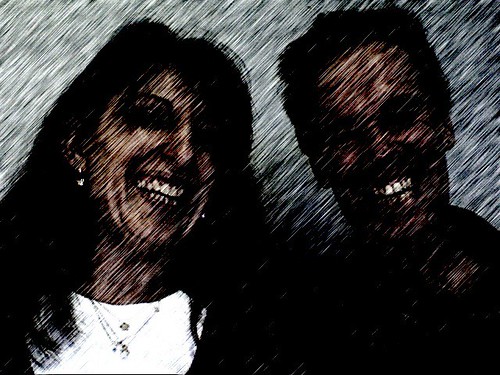Saturday, April 26, 2008
Kevin Driscoll: Dance Crze
Kevin begins his session talking bout "dance craze" and opens with a clip from YoTube (Hell's a-Poppin') from the 1940s/1950s. In this clip, there are very few cuts (camera changes), and it shows the dancers' whole bodies. It's also possible to see the band playing in certain shots. It would actually possible to learn the whole dance from watching the video. We move a decade on to television and Chubby Checker singing "Let's Twist again" and doing the twist. the space within which he's dancing in a non-space and is presented s a singer first, and a dancer second. Another decade on, we have "Saturday Night Fever." Here the floor is lights synched to the msuic and a large space for John Travolta to dnace in; although it's still not clear where the actual music is coming from. In the next clip, the Bangles ae playing and singing to "Walk Like an Egyptian". Here we have the singers singing, but all the people in their audience dancing to the song, and then random shots of everyday people also dancing to the song.
Kevin's talk then moves to focus on television shows that focus on dancing itself. this includes regional television dance shows. The Corny Collins' show in the early 1950s is a good example of this kind of show. In these shows, the dance is announced formally, and then viewers are given full-body shots of the dancers. But, for Kevin, it's the disco Era is when dance crazes really take off. The show, Solid Gold, is a good example of this kind of show. Kevin describes how within the YouTube comments, fan are reminiscing about the show *and* about being particular fans of specific dancers within the show. "Dance Party USA" is another example from the Disco era that focussed on the dancers by inviting viewers to send in questions to be asked of specific dancers. The MTV created a show called The Grind (circa early 1990s). The clip that Kevin shows us features random people dancing to music out by a pool, mixed with clips from the featured band's concert footage. Kevin describes this show as a live action remix dances.
In the 200s, rap music videos include lots of random, everyday folk dancing singly or in enormous groups to a song (e.g., Dem Franchise Boys and their snap music songs). In this song, the song is about the dance and the dance is about the song, and they're difficult to extricate. DJ Unk's "Walk it Out" is next. This clip includes choreographed as well as live action dancers. the band advertised that they were making this clip and sked everyone to come and participate. Some turned up wearing distinctive t-shirts so they'd stand out in the crowd. Next up is "Pop, Lock It, Drop It". in this video, while the song is about dancing nd includes dancers, but the shots are of body parts and suchlike, along with a narrative about school, so it's nonetheless difficult to actually see the dance happening. This music video spwaned a bunch of response videos showing the entire dance in action and made by random fans. These clips are full-body shots. Two of the three fan dance videos are filmed at school (with one being sung by the school girl dancers themselves). these videos feature young, African American youth.
Kevin recounts how as a as a computer science teachers people would talk to him about how African American kids were being excluded from the internet, but he's found boundless evidence that many Black youth indeed *are* participating in a rich range of digital practices and do have a presence online.
He gives a quick overview of the history of sampling; from turn-tables through to sampling computers. Interestingly, both turntables and sampling computers feel from favour. When they became cheaper, though, people began repurposing them and really leveraging the kinds of imperfect sounds that could be obtained from these tools (e.g., dragging sounds out, changing tempo etc.).
Soulja Boy--a highschool student--is an interesting phenomenon as a young lad making songs and getting them out and about, then perhaps up to a year later fans making videos of his songs and posting them online. The Cash Camp Click--friends of Soulja boy--make regular dance videos for his songs. The video they made for "Crank that!" essentially becomes *the* Soulja Boy dance.
Kevin has also been reading Soulja Boy's Myspace page and is fascinated by how his comments have changed over time from people who know him as friends, through to fans of his music, and how this shift sometimes creates tensions within the comment threads of his Myspace page. Over time, as "Crank that, Soulja Boy" becomes more popular, he explicitly invites people to submit their own dance videos for posting to his Myspace website. what these videos start to show is the "standardisation" of the Cash Camp Kids' original dance for this song. Kevin also points out how interesting the settings of the videos are, as wel as what people are wearing, etc. Then, after some time, Mr. Collipark--a record label owner--gets in touch with Soulja Boy and signs up to a recording contract. Soulja Boy nonehteless makes enormous efforts to maintain his MySpace fanbase; he regularly updates his MySpace profile, gives shout-outs to fan posters in his live concerts; tlks about getting new PlayStation in his MySpace profile etc.
Kevi then plays a range of videos representing identity; this spans the "preppy version" by three hite lads (who spell "Soulja Boy" as "Soldier Boy" and who are wearing cargo pants and polo shirts (see "Stuff White People Like"). In the second video, it's actually difficult to make out the dancer's ethnicity. This clearly must've been contentious because he's (re)labelled his video "I'm Black, you fucks." He includes new dance moves. The third video is titled "The Whitest Black Soulja Video" an seems to have been posted by the "friend" of the Black dancer in the video, with the title seeming to be a commentary on the uality of the dancing in the video. Kevin then shows an American Gridiron team dancing to the song just before a game, followed by a video of cheerleaders using the song s a warm-up exercise. the best of this lot is a classic ballet interpretation of the dance! Priceless! Kevin points out people may be using this song/dance to express solidarity with others.
then we're treated to a range of music video remixes using the song and using, say. Winnie the Pooh, a World of Warcraft machinima dance clip, and a Sponge Bob Square Pnts version. this is followed by range of fan videos including "Crank that, Robocop" and "Crank That, Geek" versions.
In summary, Kevin talks about the "crank that" phenomenon as having a high "welcomingness" in that people feel welcome to change the song and the dance and make it their own. Interestingly, when the record company puts out its "official" music video, it actually features the unofficial music videos within the clip. This clip, therefore, includes shots of Soulja Boy singing, outside shot of people dancing, crowd dances, and so on. Then Soulja boy and his friends have also made an instructional video on how to do the dance. We watch this a few times, then make our own "Crank that, ROFLcon" dance vdieo!" Stay tuned for links!!
Kevin has placed links to all the clips he used in his presentation here: http://kevindriscoll.info/docs/presentations/workit/#(1)








